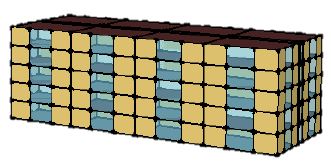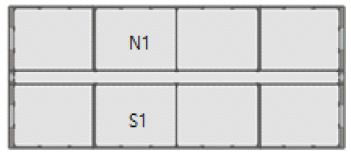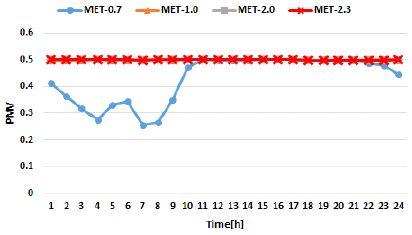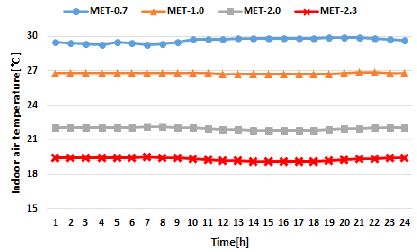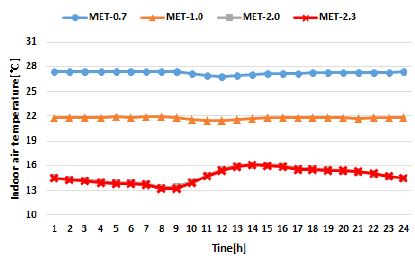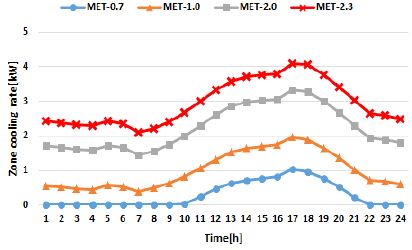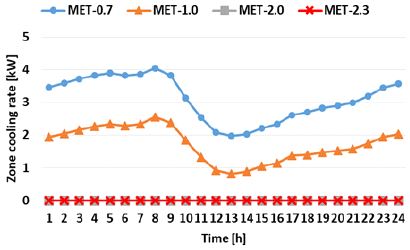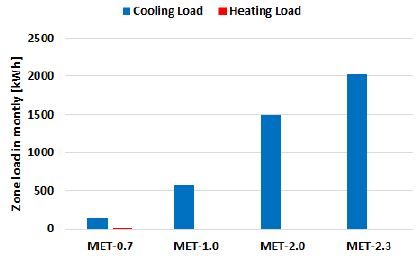
Variations of PMV based Thermal Comfort and Cooling/Heating Load according to MET
ⓒCopyright Korea Institute of Ecological Architecture and Environment
Abstract
Korean government originally established the target of greenhouse gas emission reduction by 30% by the year of 2020, but adjusted the target to 37% reduction by 2030, recently. The efficient indoor environmental control is an essential factor for the achievement of the goal. However, most of the indoor environment control is based on the dry-bulb air temperature, which is one of the most simplified control methods having limitation to truly represent thermal comfort of individual occupants. A variety of factors affect the thermal comfort such as dry-bulb air temperature, humidity, air movement, radiation, clothing insulation and metabolic activity level.
In this circumstance, this study investigated the effects of MET (metabolic rate) on thermal load and PMV, which is the thermal comfort index considering all the comfort factors listed above. Four cased were simulated using EnergyPlus: Case1: 0.7 (Sleeping), Case2: 1.0 (Seated, quiet), Case3: 2.0 (Walking), Case4: 2.3 (Fast walking, Dish washing).
It turned out that indoor air temperature in MET 0.7 Case can be even 10℃ higher than that in MET 2.3 Case to accomplish the same PMV in the summer period and that MET has dominant effects on heating and cooling load in residential buildings.
Keywords:
PMV Control, MET(Metabolic Rate), EnergyPlus키워드:
PMV 제어, 신진대사 해당치, 에너지플러스1. Introduction
1.1. Background of the Research
Energy consumption problem has been recognized as an important issue in the society as well as everyday life because global warming becomes deepen globally recently. Our country also participated in New Climate Change Regime agreement to counteract the climatic change after 2020 now. With this agreement, our country established the target of greenhouse gas emission reduction as 37% in comparison with Business as Use (BAU) until 2030 [1]. Also, our country depends on 97% of the energy source used in the nation by import and the energy consumed by the building is about 28% of total energy consumption [2]. Furthermore, the demand for the technology can realize more comfort indoor space than existing system minimizing the energy of building air conditioning system due to improved quality of life than the past has been increased. Especially, Predicted Mean Vote (PMV) is 7 step criterion of thermal comfort with range of use for –3 to 3 which was designated by American Society of Heating Refrigerating and Air Conditioning Engineers (ASHRAE). Generally, comfort range is considered for the range of –0.5 to 0.5 status. Relevant studies in various ways such as MET, PMV, highly efficiency air conditioner and so on is actively progressing these days.
1.2. Advanced Research Consideration and Purpose of the Research
To review current trend of research for indoor thermal comfort energy performance evaluation according to PMV control inside and outside of the country, indoor thermal comfort energy performance evaluation by PMV control through Energy Plus simulation was performed by Jang et al. in Korea. Based on the result, actual temperature is higher than room temperature control reflecting other thermal comfort factors in case of comfort control using PMV index. Also, the rate of comfort range ± 0.5 in PMV is average 1/3 of inside zone and outside zone though energy consumption is less when set heating as 20℃ and cooling as 26℃according to the energy conservation design standard [3]. Kim et al. performed the research for thermal environment comfort for each apartment house by applying Adaptive PMV and performed survey and analysis to consider amount of clothing and amount of action. There is 46% satisfaction in comparison with energy conservation design standard based on the analysis for each lowest floor, intermediate floor and highest floor [4]. Adaptive PMV model has been developed to increase PMV expectation performance by Kim et al. at foreign country. Based on the result, two types of PMV model has been developed and PMV model based on Black-box theory shows excellent expectation performance within ±1.5 range and the expectation result of Adaptive Comfort model corresponds to real sense of the human comfort when the temperature is 17~30℃ [5]. To sum up, there is a limitation that the amount of clothing has been fixed as 0.5 for summer and 1.0 for winter according to ISO standard and controlled PMV in a lump regardless of MET alteration in existing researches.
One of the limitations of critical point for PMV control reviews above is that MET which is one of main decision factors has been evaluated with the fixed value. It is judged that the utilization and accuracy will be improved than the existing PMV control when MET alteration is evaluated in real time using actual measurement method of MET. Therefore, the purpose of this research is to evaluate the effect of MET alteration on PMV based thermal environment and load as a preceding stage.
2. Theoretical Background
2.1. Predicted Mean Vote (PMV)
PMV is one of the representative thermal index which is a comfort index suggested by P. O. Fanger and adopted and used by ISO 7730. There are temperature, humidity, air current velocity, average radiant temperature, metabolism, amount of clothing and so on for environmental elements affecting thermal comfort of human body, and PMV is mean vote felt by human body considering above mentioned environmental elements. Also, predicted mean vote is divided as 7 stages and it is shown in Table 1 and the calculating formula is same as formula (1). General range of comfort for the person inside is –0.5 to +0.5.
| (1) |
In here,
M : Metabolic rate, unit: W/m2,1metabolic unit = 1met = 58W/m2 at human body surface
W : External work, unit: W/m2, 0 at most of activity
Icl : Thermal resistance of clothing, unit: m2℃/W, 1unit of thermal resistance of clothing=1clo=0.155m2℃/W
fcl : Human body surface area rate when put on the clothes in comparison with human body surface area when naked
ta : Air temperature, unit: ℃
t : Mean radiant temperature, unit: ℃
Var : Relative air velocity, unit: m/s
Pa : Partial water vapour pressure, unit: pascals
hc : Convective heat transfer
tcl : Surface temperature of clothing, unit: ℃
2.2. Metabolic Equivalent of Task (MET)
MET is a physiological criterion expressing the metabolism during physical activity and 1 MET means the volume of oxygen consumed when an adult is seated during rest. It can be expressed as (O2ml/kg/min)*3.5 [6]. Following Table 2[7] shows the metabolic rate based on various activity conditions. Activity Level is an index deciding heat production per each person based on the activity and the unit is W/Person. Minimum value of it is 72 W/Person when sleeps and maximum value is 216 W/Person and it shows heat production per each person for various indoor activities [7].
3. Method and Range of the Research
3.1. Analysis Tool Selection
EnergyPlus which is developed by U.S Department of Energy has been used in this research. EnergyPlus adopts Heat Balance method which is recommended by American Society of Heating Refrigerating and Air-conditioning Engineers (ASHRAE) for building heating and cooling load analysis. The reliability of the program was verified by the guideline of ASHRAE 140 which is representative regulation for dynamic simulation tools [6]. Also, it is possible to perform HVAC system analysis related to thermal behavior between system and building, and especially, it has advantage that can simulates integrated solution of each component consisting of zone, surface, air heat balance, system and plant modeling for each time step, and thus it has been selected as an analysis tool for this research.
3.2. Simulation Model
High-rise residential building prototype model based on ASHRAE Standard 90.1 provided by EnergyPlus has been used for material property of construction materials and internal heat gain schedule was applied to target building for analysis as shown in Fig. 1. 46m of width and 17m of depth as floor area and 2.7m of height and 35% of window area ratio was set for typical 5 story apartment. Also, the weather data of Seoul provided by the Korean Solar Energy Society was used. Fig. 2 is a plan for each zone of the building and South 1 zone (S1) of third floor which has less thermal influence from ceiling and floor was chosen as target zone for analysis. Indoor heat gain is summarized in Table 3 based on ASHRAE Standard 90.1 and indoor cooling and heating temperature was set as 26 ℃ and 20 ℃. The cooling and heating is considered to operate for 24 hours. IdealLoadsAirSystem model which can evaluate the cooling and heating load by excluding the efficiency of HVAC System and Plant on EnergyPlus was used as air conditioning system. Representative days for summer and winter was selected as each Aug. 8th and Jan. 21st and PMV range was maintained within ±0.5 by indoor dry-bulb temperature control. Total 4 cases with constant MET value for whole year were selected as Table 4 to analyze PMV and air conditioning and heating load according to MET change in this research.
4. Analysis and Consideration for the Result
4.1. PMV Analysis for Summer
Fig. 3 shows the PMV value according to MET change on representative day of summer, Aug. 08th. It is confirmed that PMV maintains as 0.5 in most of the time excluding MET value 0.7. The reason that PMV value was maintained as 0.5 which is PMV set value regardless MET value is that indoor dry-bulb air temperature is properly controlled based on MET value. PMV is not fixed and maintained under value than 0.5 from 01:00 to 09:00, and it is considered that there is no cooling load due to very low human body heat because MET 0.7 means the activity of the person inside is sleeping (Fig. 7). That is, it is considered that it shows low PMV which the person inside does not feel the heat though air conditioning system does not operate from 01:00 to 09:00. Whereas, it is judged as the reason that PMV becomes 0.5 with same as other cases from 10:00 is that air conditioning load is generated because the increase of insolation comes to the inside and also increase of outdoor temperature (Fig. 7).
4.2. PMV Analysis for winter
Fig. 4 shows PMV variations of representative day of winter, Jan. 21st. It is confirmed that heating comfort is properly controlled because PMV is in the range of ±0.5 in all cases by indoor dry-bulb air temperature control. There is big difference on PMV according to MET condition in winter, compared to summer. PMV becomes higher when MET becomes higher, and PMV set value of –0.5 for winter is maintained for every hour of MET 0.7 and 1.0. It is judged that air conditioning system is operated by generating cooling load because human body heat is not high on MET 0.7 and 1.0 (Fig. 8). However, PMV is not fixed as –0.5 and maintained over than this value in case of MET 2.0 and 2.3 and it is considered that air conditioning system is not operated because human body heat is high (Fig. 8). That is, it is considered that there was high PMV in which the person inside does not felt cold even if air conditioning system was not operated. Based on the review of PMV change for each time for the case of MET 2.0 and 2.3, PMV is decreased from 01:00 to 09:00 due to change of indoor dry-bulb temperature based on the decrease in outdoor temperature and PMV is increased from 10:00 with the increase in outdoor temperature.
4.3. Indoor Air Temperature according to MET
Fig. 5 and 6 shows indoor air temperature variations of summer (Aug. 08th) and winter (Jan. 21st). Indoor air temperature becomes lower when MET becomes higher for both summer and winter and the difference is considerably high. Based on the review for average indoor air temperature for one day in summer, quite high indoor air temperature can be observed around 29℃ when MET is lowest as 0.7, indicating that PMV can be maintained below 0.5 with low amount of activities though indoor air temperature is as high as 29℃ under MET 0.7 condition. Whereas, average indoor air temperature for one day is the lowest around 19℃ when MET is highest as 2.3. The temperature difference between two cases are 10℃, indicating that indoor air temperature deviation to maintain the same PMV in such different amount of activities in human body is significantly high as above and it is confirmed that amount of activities in human body significantly affects PMV. Also, average indoor air temperature is about 14℃ when MET is 2.3 in winter, indicating that it is possible to maintain PMV higher than 0.5 due to higher amount of action though indoor air temperature is low as 14℃ under MET 2.3 condition. However, indoor air temperature is 27℃ when MET is 0.7 and there are temperature difference of 13℃ under same PMV control condition. In case of comparison between MET 2.0 and 2.3, there are temperature difference in summer, but almost no difference in winter. It is judged that indoor air temperature is similar because heating load is not generated and heating system is not operated due to high amount of action in human body when MET is more than 2.0.
4.4. Cooling Load Analysis for Representative Dayin Summer
PMV control range was set as ±0.5 through indoor dry-bulb air temperature control and cooling load for each hour of representative day in summer (Aug. 8th) is shown in Fig. 7. Cooling load becomes higher when MET value becomes higher and the cooling load is the highest from 17:00 to 18:00 in every case regardless with MET value. There was no cooling load from 00:00 to 10:00 at MET 0.7, which is different from other cases and cooling load is generated from 11:00. It is considered that comfort can be maintained though air conditioning system is not operated from 00:00 to 10:00 in which the solar radiation and outdoor temperature are low due to very low activity of human body at MET 0.7 and cooling load is generated from 11:00 because outdoor temperature and solar radiation becomes higher. Indoor air temperature is controlled as lower value due to higher amount of activity than 0.7 for the cases having MET values greater than 1.0. Therefore, cooling load is generated from 00:00 and the highest cooling load is shown in case of MET 2.3 because indoor air temperature is controlled as lower value when MET value is higher.
4.5. Heating Load Analysis for Representative Day in Winter
Heating load for representative day in winter (Jan. 21st) is as shown in Fig. 8. Heating load becomes higher when MET values becomes smaller and heating load was 0 for MET 2.0 and 2.3. It is considered that comfort can be maintained though heating system is not operated due to higher activity of human body for MET 2.0 and 2.3. However, heating load is generated because indoor temperature is increased to maintain PMV more than –0.5 in case of MET 0.7 and 1.0. Also, the highest heating load can be observed from 08:00 to 09:00 and decreased heating load can be observed until 13:00 and gradually increased again in case of MET 0.7 and 1.0. It is judged that heating load decreases due to increased solar radiation and outdoor temperature from 08:00 and again increases due to decreased outdoor temperature and solar radiation from 13:00.
4.6. Monthly Cooling and Heating Load Analysis
Fig. 9 and 10 show monthly cooling and heating load accumulation for Jan. and Aug. There was the highest heating load at MET 0.7 which shows lowest amount of activity for Jan. Also, heating load was mainly generated due to low amount of activity and low outdoor temperature in case of MET 0.7 and 1.0 with cooling load showing 0. There was low heating load due to high activity of human body in case of MET 2.0 and 2.3 though it is winter and rather cooling load is higher than heating load. Lowest total load showed cooling load and heating load of 18.54kWh and 0.37kWh at MET 2.0 and highest total load showed cooling load and heating load of 264.11kWh, although it is 0kWh for heating load at MET 2.3.
Cooling load is generated in Aug. due to high outside temperature and solar radiation. Therefore, heating load was not generated in all the cases except MET 0.7 and shows higher cooling load when MET value becomes higher. There was 16 times of cooling load difference between MET 0.7 and 2.3, and 3 times of monthly cooling load difference between MET 1.0 and 2.0. Especially, slight monthly heating load as about 11.23kWh is generated because heating load is generated on the hours when solar radiation is low due to very low amount of action in case of MET 0.7.
5. Conclusion
Five story typical residential building has been simulated by EnergyPlus and indoor dry-bulb air temperature was controlled to maintain PMV range within ±0.5 which is comfort range of indoor environment in this research. Indoor thermal comfort and cooling and heating load analysis according to MET change using previously constructed model was evaluated, and the result is as follows.
(1) PMV of all case in summer and winter could be controlled within comfort range through proper indoor dry-bulb air temperature control and shows high PMV deviation according to MET level change. Especially, relatively high PMV deviation in winter than summer can be observed due to the feature of heating oriented residential building.
(2) Cooling load was not necessary in summer for MET 0.7 and heating load was not necessary in winter for MET 2.3.
(3) Indoor dry-bulb air temperature were low for PMV control when MET level is high in both summer and winter and the difference of indoor air temperature for PMV control was maximum more than about 10℃.
(4) Cooling load in summer was 0 for lowest MET level of 0.7, which was different from other cases having higher MET values, and it is considered that comfort can be maintained without cooling system operation due to very low amount of activity at MET level of 0.7. Similarly, there was no heating load in winter for high MET level of 2.0 and 2.3.
(6) It was confirmed that the influence of amount of activity in human body on thermal comfort is significant judging by the big difference in cooling and heating load accumulation value in Jan. and Aug. depending on MET level change. Especially, heating load was low though it was winter due to high amount of activity in human body in case of MET 2.0 and 2.3, and cooling load was higher than heating load.
Indoor thermal comfort and cooling and heating load analysis according to different MET conditions fixed at particular values has been performed in this research. Based on this research, it was confirmed that MET has significant impacts on PMV and thermal load, and that energy consumption after applying actual HVAC system will be evaluated in the future. Also, evaluation for thermal comfort sensation and energy consumption under actual hourly MET condition variations for real occupants is necessary.
Acknowledgments
This research was supported by a grant (code 17CTAP- C129762-01) from Infrastructure and Transportation Technology Promotion Research Program funded by Ministry of Land, Infrastructure and Transport of Korean Government.
Notes
References
- Park, Jun-Taek, “Measures to Reduce GHG Emissions in Building”, Korea Association of Air Conditioning Refrigerating and Sanitary Engineers, Vol.34(No. 8), (2017).
- Seo, Byeong-Mo, “Comparison of Cooling Energy Performance Between Conventional AHU System and DX AHU-Water Source VRF Heat Pump System in an Office Building”, Hanbat National University, Master's Thesis., (2017).
-
Jang, Hyang-In, Suh, Seung-Jik, “Analysis of Indoor Thermal Environment and Energy Consumption in Office Building Controlled by PMV”, The Korean Solar Energy Society, Vol.33(No. 4), (2013).
[https://doi.org/10.7836/kses.2013.33.4.015]

- Kim, Ok, Kim, Mi-Yeon, Lee, Mi-Yeon, Kwon, Yoon-Ji, Kim, Hyung-Geun, “Study on the Thermal Environmental Comfort by Household Location in Residential Apartment Building in the Winter”, Korean Institute of Architectural Sustainable Environment and Building System, Vol.10(No. 1), (2016).
-
Kim, Jeong-Tai, Lim, Ji-Hyun, Cho, Sun-Ho, Yun, Geun-Young, “Development of the Adaptive PMV Model for Improving Prediction Performances”, Energy and Buildings, Vol.98, (2015).
[https://doi.org/10.1016/j.enbuild.2014.08.051]

- M. Jette, K. Sidney, G. Blumchen, “Metabolic Equivalents (METS) in Exercise Testing, Exercise Prescription, and Evaluation of Functional Capacity”, Department of Kinanthropology, School of Human Kinetics, University of Ottawa, Canada, Vol.13(No. 8), (1990).
- The U.S. D.O.E., EnergyPlus Engineering Reference, The Reference to EnergyPlus Calculations, (2011).

